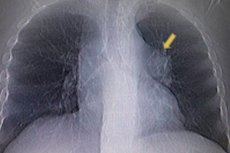Medical expert of the article
New publications
Pulmonary aneurysm
Last reviewed: 29.06.2025

All iLive content is medically reviewed or fact checked to ensure as much factual accuracy as possible.
We have strict sourcing guidelines and only link to reputable media sites, academic research institutions and, whenever possible, medically peer reviewed studies. Note that the numbers in parentheses ([1], [2], etc.) are clickable links to these studies.
If you feel that any of our content is inaccurate, out-of-date, or otherwise questionable, please select it and press Ctrl + Enter.

Aneurysm of the arteries of the pulmonary vasculature or pulmonary aneurysm is a focal dilatation (focal dilation) of the vessel wall with the formation of a bulge beyond its normal diameter.
Epidemiology
According to some data, the incidence of pulmonary aneurysms is no more than seven cases per 100,000 population, and 80% of cases are pulmonary artery trunk aneurysms.
In the presence of congenital heart disease, the prevalence of pulmonary aneurysm is estimated to be approximately 5.7% and 30-60% in cases of long-term pulmonary arterial hypertension.
Causes of the pulmonary aneurysms
Pulmonary aneurysm can occur in pulmonary trunk and its branches - right or left main pulmonary arteries, which originate at the bifurcation of the pulmonary trunk and together with smaller branches form the small (pulmonary) circulation circle originating in the right ventricle of the heart.
What are the causes of pulmonary aneurysm, which is considered a rare pathology of the vascular system?
Iatrogenic causes may include cardiac surgery, placement of a catheter in the pulmonary artery or a drainage tube in the pleural cavity, lung biopsy for suspected cancer, or radiation therapy of the chest organs.
There may be an etiologic association with congenital heart defects, mainly interventricular or interatrial septal defect or open ductus arteriosus.
Limited bulging of the arterial vessel wall is quite often caused by diseases that affect connective tissue: behçet's disease, cystic necrosis of the tunica media (the middle sheath of the vessel wall), Ehlers-Danlos or Marfan syndromes.
The formation of pulmonary aneurysms has been traced to patients with increased pressure in the small circulation circle - pulmonary hypertension, with pulmonary artery stenosis, as well as damage to the vascular wall due to chronic pulmonary embolism. [1]
Risk factors
As risk factors for the formation of a pulmonary artery aneurysm, experts name: penetrating chest trauma; neglected tuberculosis or syphilis; staphylococcal and streptococcal infections provoking septic pulmonary embolism; infective endocarditis; pneumonia (viral, bacterial or fungal); bronchiectatic disease; lung tissue lesions - interstitial lung diseases (idiopathic pulmonary fibrosis, hypersensitivity or nonspecific pneumonitis, sarcoidosis, etc.).). [2]
Pathogenesis
In contrast to false, in true pulmonary artery aneurysms, the focal dilation of the vessel affects all three layers of its wall. The pathogenesis of such dilatation lies in a decrease in the elasticity, elasticity and total thickness of the vascular wall, which under the constant dynamic load of blood flow stretches to form a bulge.
In congenital heart disease, the mechanism of formation of such a bulge is explained by an increase in blood flow caused by its discharge from left to right (due to shunt formation) and the effect of hemodynamic shear stress on the vascular wall, which can cause its local structural changes and transformation into an aneurysm. [3]
Symptoms of the pulmonary aneurysms
A small pulmonary artery wall bulge may be asymptomatic, and the first signs a larger aneurysm may present include shortness of breath and chest pain.
Clinical symptoms such as palpitations, fainting, hoarseness of voice, cyanosis, coughing and hemoptysis (coughing up blood) are also noted.
In this case, shortness of breath may increase, and the lungs develop an inflammatory process in the form of pneumonia. [4]
Complications and consequences
How serious the consequences and complications of pulmonary aneurysms are, can be judged by the mortality rate caused by the rupture of a pulmonary aneurysm, accompanied by intrapulmonary hemorrhage and asphyxia. According to clinical statistics, the mortality rate is 50-100%. [5]
Also, dissection of the pulmonary artery affected by the aneurysm can lead to sudden cardiac death (cardiac arrest).
In milder cases, complications develop in the form of pulmonary embolism and heart failure.
Diagnostics of the pulmonary aneurysms
To detect an aneurysm, instrumental diagnostics including chest X-ray, ECG, echocardiography, chest CT scan, MRI or cT angiography.
Given the nature of the symptoms of pulmonary aneurysm, differential diagnosis should exclude quite a few diseases and pathologic conditions that have a similar clinical picture.
Who to contact?
Treatment of the pulmonary aneurysms
In cases of asymptomatic pulmonary aneurysms, there is an option of conservative therapy, which includes treatment of the disease that caused the pathology (if possible) and monitoring of the aneurysm with periodic visualization of the affected vessel.
In more complex cases, surgical treatment is required to prevent aneurysm growth or rupture by aneurysmorrhaphy (excision of excess vascular wall tissue) or aneurysmectomy (excision of the entire aneurysm), as used for saccular aneurysms. Or endovascular spiral embolization of the aneurysm, which is used both for saccular bulges and spindle-shaped aneurysms of the peripheral pulmonary arteries. [6]
Spiral stent embolization, in which an aneurysm is embolized through a metal stent that maintains patency of the vessel, may also be performed. [7]
More information in the materials:
Prevention
No special measures have been developed for the prevention of pulmonary aneurysms, and all traditional medical recommendations concern the need to lead a healthy lifestyle.
Forecast
Because of the difficulties in diagnosing pulmonary aneurysms and the possibility of fatal complications, the prognosis of this vascular pathology cannot be considered favorable for all patients.

